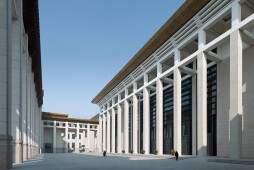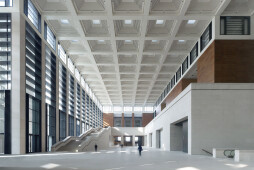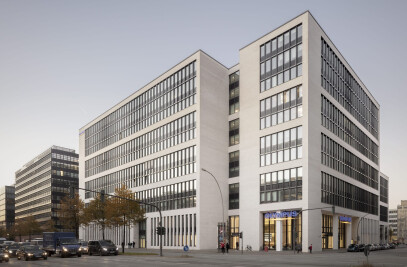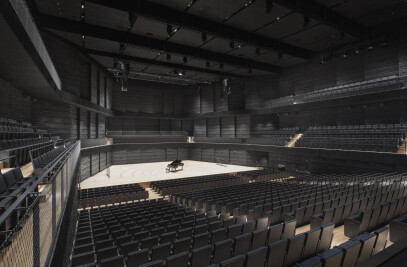The conversion and extension of the Chinese National Museum combines the former Chinese History Museum with the Chinese Revolutionary Museum. Completed in 1959 as one of ten important public buildings in Tiananmen Square, in direct proximity to the Forbidden City, the museum is still a milestone in the history of modern Chinese architecture. Outline plans were invited from ten international architectural firms and the project was awarded to Gerkan, Marg & Partners (gmp) for its submission, together with Beijing’s CABR, ahead of Foster & Partners, Kohn Pedersen Fox, OMA & Herzog & de Meuron. The original GMP submission envisaged gutting the existing museum. The central block would be removed and the large space thereby created spanned by a bronze flying roof linking the old building and the new one. Following a discussion with the client and Chinese architectural experts, this scheme was revised, with the aim of integrating more of the external impact of the old building in the new building, though without abolishing the immediately obvious distinction between old and new. This would allow the building to illustrate the continuity of history. The aim was to join the northern and southern wings in a single complex, by removing the central structure. The 260 metre long hall acts as its central access area. It widens to embrace the existing central entrance which opens onto Tiananmen Square. The ‘forum’ thus created acts as an atrium and multi functional events area, with all services for the public, that is to say, cafes and tea shops, book shops and souvenir stores, ticket offices and toilets. The classic three-part division of Chinese historic buildings also dominates the design of the ‘forum’. A stone base serves as a platform for a wooden structure, with a coffered roof resting on a grid. For this coffered roof extending along the entire forum and in the central Hall, iGuzzini developed a special luminaire which uses light to help create the welcoming atmosphere that was required throughout the building. This atmosphere is also created by the harmonious use of materials: local granite for the floor and walls of the base layer and wooden cladding in the gallery area. Rooms of particular importance can be recognised by the use of different materials. The central hall opposite the main west entrance and the theatre have red wall coverings to improve acoustics. The museum’s main entrance continues to face west but, for the first time, the north and south entrances are linked by the ‘forum’. The architectural form of the space is a contemporary interpretation of traditional elements of Chinese buildings. This is already obvious in the west courtyard, accessed via broad steps reminiscent of the steps in front of the temple precincts in the Forbidden City just around the corner. The west entrance of the current building, the “Mengguobao” facing Tiananmen Square is notable for a series of wonderful pillars, linked to each other by an entablature in the style of temple and palace architecture, with the roof structure resting on it. In historic Chinese architecture this sophisticated system of beams and shelves supporting the roofs of imperial palaces is called ‘dougong’. The western facade of the new building is designed in a similar fashion. The entrance doors to the new buildings are made of perforated bronze plates that filter the daylight, producing a muted atmosphere, like that of traditional Chinese buildings obtained through typical decorated shutters. The motif of the perforation was inspired by an ancient bronze panel - one of the extraordinary items among the one million works of art that make up the National Museum collection. This ornamentation also recurs in the form of the balustrades inside the museum. The north wing facing Chang’an Avenue houses the exhibition of Chinese modern history, while the south wing houses the administrative offices and the library. In the new building, the main exhibition areas are distributed over four superposed storeys north and south of the central hall, where state receptions, banquets and similar events are held. Below the central hall there is a cinema and a theatre, an events room suitable for conferences and, thanks to the fine acoustics, classical music concerts and other events requiring a stage. The base level and basements contain the museum’s laboratories and workshops, storerooms and the underground garage.








































